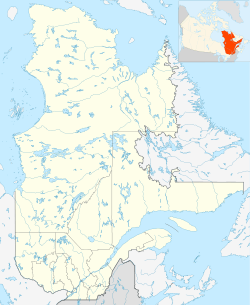Wemindji facts for kids
Quick facts for kids
Wemindji
ᐐᒥᓂᒌ (Cree)
|
|
|---|---|
|
Cree community
|
|
| Etymology: Red ochre mountain | |
| Country | Canada |
| Province | Quebec |
| Region | Northern Quebec |
| TE | Eeyou Istchee |
| Government | |
| • Type | Cree reserved land |
| Area | |
| • Land | 387.37 km2 (149.56 sq mi) |
| Population
(2021)
|
|
| • Total | 1,562 |
| • Density | 4/km2 (10/sq mi) |
| Time zone | UTC−5 (EST) |
| • Summer (DST) | UTC−4 (EDT) |
| Postal Code |
J0M 1R0
|
| Area code(s) | 819 |
Wemindji (which means "red ochre mountain" in the Cree language) is a small Cree community. It is located on the east coast of James Bay in Quebec, Canada. This community is home to the Cree Nation of Wemindji.
About 1,500 people live in Wemindji. Most of them are part of the Cree Nation of Wemindji. The community is represented in the Canadian government by a member of Parliament.
The leaders of Wemindji include a chief, a deputy chief, and five councillors. These leaders are chosen by the people of the Cree Nation of Wemindji. The current chief is Christina Gilpin. The deputy chief is Arden Visitor. The councillors are Elmer Georgekish, Bradley A.J Georgekish, Paul John Murdoch, Stanley Shashweskum, and Ernest Tomatuk. These leaders are elected every four years.
You can reach Wemindji by flying into Wemindji Airport. Since 1995, you can also drive there on a gravel road connected to the James Bay Road. The big city of Montreal is about 1,400 kilometers south of Wemindji.
Even though Wemindji is a small community, it has many useful services. These include schools (for elementary and high school students), a clinic, and a wellness department. There are also motels, a bed and breakfast, a shopping center, and a police station. The community also has two daycares, an after-school program, tradition centers, sports facilities, and a fire station.
Contents
History of Wemindji
Wemindji is a fairly new community. The Cree families who live here originally came from an older trading post. This post was called "Paakumshumwashtikw" in Cree, or "Old Factory" in English. It was founded in the 1600s.
In 1959, the community moved about 45 kilometers north to where Wemindji is today. The name Wemindji comes from the red color found in the hills around the area. This red color was used as a pigment.
The James Bay Agreement
The Cree Nation of Wemindji is one of nine communities that signed the James Bay and Northern Quebec Agreement. This important agreement was signed in 1975. It was made between the Cree, the Inuit, the Quebec government, and the Canadian federal government.
Before the agreement, the Cree people went to court. They wanted to protect their rights to their land. This was because of plans for hydro development (building dams for electricity) that did not respect their land rights.
The James Bay and Northern Quebec Agreement was a very important step. It was the first major agreement between the Canadian government and Indigenous peoples since the 1800s. It was negotiated from 1973 to 1975 and signed on November 11, 1975.
Through this agreement, the Indigenous people traded some land rights for other important benefits. They gained special rights to manage their own local and regional governments. They also created their own health and school boards. The agreement included plans for economic growth and community development. It also set up special rules for police, justice, and protecting the environment.
The agreement also defined the La Grande Project, a large hydro development. It set limits on water levels and created a group to fix any social or environmental damage. It also helped with the relocation of the first dam.
The land was divided into three types in the agreement:
- Category 1 land: This land is mainly controlled by the people living in and around the Indigenous communities.
- Category 2 land: This is Crown land (government land). It is used for hunting, fishing, and trapping. It is shared between the Cree and Inuit peoples.
- Category 3 land: This land is used only by Indigenous people for traditional hunting and harvesting.
Cree Culture and Traditions
The Cree people have always called themselves iIyiyuuch, which means "the people." They continue to practice their traditional ways of hunting, trapping, and fishing. Some people in Wemindji still live off the land all year round.
Languages Spoken
In Wemindji, two main languages are spoken: Cree and English.
Education in Wemindji
The Cree School Board oversees education for all nine Cree communities. In Wemindji, the Cree School Board runs two schools. These are the Maquatua Eeyou School (ᐧᒫᑯᐧᑖᐤ ᐄᔨᔨᐤ ᒋᔅᑯᑎᒫᑑᑭᒥᒄ) and the Joy Ottereyes Rainbow Memorial School.
The Maquatua Eeyou School is the high school. The Joy Ottereyes Rainbow Memorial School is the elementary school. Both schools focus on teaching the Cree language. English is taught as a second language in both schools.
Cree First Nations Communities
Wemindji is one of the nine Cree First Nations communities that make up the Cree Nation of Eeyou Istchee. Eeyou Istchee means "people's land." The people call themselves “Eeyou.”
Along with their 11 Cree communities, there are over 300 traditional family hunting and trapping areas. These are called “traplines.” Each Cree First Nation community has its own unique history.
Each community manages itself through its local government. However, issues that affect the entire Cree Nation are discussed by elected chiefs. These chiefs serve on the board of directors for the Grand Council of the Cree and the Council of the Cree Nation Government.


